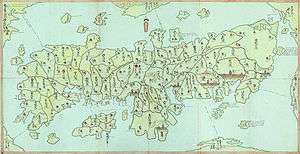Kanō Domain
The Kanō Domain (加納藩 Kanō-han)was a Japanese domain of the Edo period. It is associated with Mino Province in modern-day Gifu Prefecture.[1]
In the han system, Kanō was a political and economic abstraction based on periodic cadastral surveys and projected agricultural yields.[2] In other words, the domain was defined in terms of kokudaka, not land area.[3] This was different from the feudalism of the West.
History
Before the battle of Sekigahara, the central Mino Province was ruled by Oda Hidenobu, Oda Nobunaga's grandson, its base was Gifu (岐阜). However, as Hidenobu sided with Ishida Mitsunari at the battle of Sekigahara, his territory was confiscated by Tokugawa Ieyasu, and the Gifu Castle was dismantled.
In 1601, Ieyasu granted the area to his son-in-law Okudaira Nobumasa, Gifu was renamed to Kanō (加納). Okudaira Nobumasa was allowed to build the Kanō Castle with the materials from the dismantled Gifu Castle. This was the birth of the Kanō domain.
Nobumasa's placement at Kanō was meant to act as a check against the potentially hostile lords of the west, who might have wanted to march eastward against Ieyasu. Nobumasa retired in 1602, handing over the position of daimyo to his son Okudaira Tadamasa; however, he retained 40,000 of the domain's 100,000 koku as a "retirement fund", and continued to hold actual power, establishing a system of flood control and better aiding in the setup of the castle town. Nobumasa and Tadamasa died in quick succession; the third Okudaira lord of Kanō, Tadataka, died heirless in 1632, and so the Okudaira rule in Kanō came to an end.
The last lords of Kanō, the Nagai, became viscounts in the Meiji period.
List of daimyo
The hereditary daimyo were head of the clan and head of the domain.
- Tadamoto
- Matsudaira (Toda) clan, 1639–1711 (fudai; 70,000 koku)[6]
- Mitsushige
- Mitsunaga
- Mitsuhiro
- Nobutomo
- Nobutada
- Nobunari
- Nagai clan, 1756–1871 (fudai; 32,000 koku)[8]
- Naonobu
- Naomitsu
- Naohisa
- Naosuke
- Naonori
- Naokoto
See also
References

- 1 2 "Mino Province" at JapaneseCastleExplorer.com; retrieved 2013-7-16.
- ↑ Mass, Jeffrey P. and William B. Hauser. (1987). The Bakufu in Japanese History, p. 150.
- ↑ Elison, George and Bardwell L. Smith (1987). Warlords, Artists, & Commoners: Japan in the Sixteenth Century, p. 18.
- ↑ Papinot, Jacques Edmond Joseph. (1906). Dictionnaire d’histoire et de géographie du Japon; Papinot, (2003). "Okudaira" at Nobiliare du Japon, p. 47; retrieved 2013-7-16.
- ↑ Papinot, (2003). "Ōkubō" at Nobiliare du Japon, p. 46; retrieved 2013-7-16.
- ↑ Papinot, (2003). "Toda" at Nobiliare du Japon, p. 60; retrieved 2013-7-16.
- ↑ Papinot, (2003). "Andō" at Nobiliare du Japon, p. 2; retrieved 2013-7-16.
- ↑ Papinot, (2003). "Nagai" at Nobiliare du Japon, p. 39; retrieved 2013-7-16.
External links
- "Kanō" at Edo 300 (Japanese)
